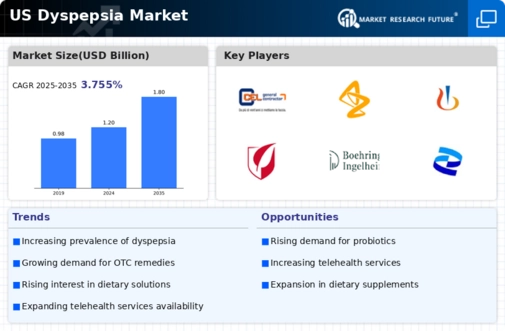US Dyspepsia Market Summary
The US Dyspepsia market is projected to grow from 1.2 billion USD in 2024 to 1.8 billion USD by 2035, reflecting a steady increase in demand.
Key Market Trends & Highlights
US Dyspepsia Key Trends and Highlights
- The US Dyspepsia market is valued at 1.2 billion USD in 2024 and is expected to reach 1.8 billion USD by 2035.
- The market is anticipated to grow at a compound annual growth rate (CAGR) of 3.75 percent from 2025 to 2035.
- Increasing awareness of gastrointestinal health is likely to contribute to the market's growth trajectory.
- Growing adoption of innovative treatment options due to rising prevalence of dyspepsia is a major market driver.
Market Size & Forecast
| 2024 Market Size | 1.2 (USD Billion) |
| 2035 Market Size | 1.8 (USD Billion) |
| CAGR (2025-2035) | 3.75% |
Major Players
Merck and Co, Celgene, AstraZeneca, Novartis, GlaxoSmithKline, Takeda Pharmaceutical, Gilead Sciences, Boehringer Ingelheim, Pfizer, Eisai, Amgen, Teva Pharmaceutical, Sanofi, Johnson and Johnson, Bayer





















